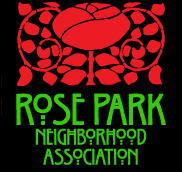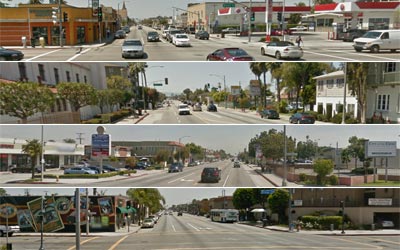The East 7th Street visioning project—the collaboration between councilwoman Suja Lowenthal’s office and a variety of other parties, including RPNA, which will culminate in the development of a strategic design document regarding the street’s future as well as a demonstration project showcasing one or more select recommendations from the culminating report—has gotten off to a great start. Feedback from the first two community input meetings, which took place in June and July, respectively, has been incorporated into the project’s findings and in the formation of ideas about how to improve the street. A third and final community input meeting will take place at MOLAA on September 20th from 10:00a to 12:00p, which persons interested in the process should attend.
For those unfamiliar with the project, here’s an overview: As mentioned, the project’s goal is to produce a meaningful development document that reflects consensus-driven opinion about East 7th Street that can then be used in the future by the City Planning Department to give it a leg up when applying for competitive grants to the MTA and similar agencies that are instrumental in helping it pay for needed infrastructure and other kinds of improvements. The project focuses on the 1.6-mile stretch of 7th Street between Redondo and Alamitos Avenues. In addition to coordinating the 7th Street Visioning Project, the council office is simultaneously carrying out studies for two other east-west corridors in our district, East 4th Street and East Broadway. Importantly, more than merely producing a written report as the culminating product of each respective study, the council office has set aside seed monies that will be used to execute a demonstration project on each street that reflects the kind(s) of solutions/improvements proposed in each of the three studies. In other words, because each of these corridors is significantly different from the other, whether in its traffic patterns, current uses, or idealized future states, the three reports and the demonstration projects that come from them will each be different. Those who participate (we remind you that all area residents are invited to participate) in the visioning workshops are not only contributing to the opinions and recommendations present in the final reports, but they are also helping to determine the location and nature of each of the demonstration projects. For persons unable to attend the first two workshops, online surveys were put up to collect feedback in the form of opinions, attitudes, needs, use patterns, and future desires. Given that the nature of the workshop discussion in the upcoming September community meeting will focus on possible solutions to the problems, needs, and wants that were identified in the previous meetings, the old survey is being replaced with one that will enable feedback useful to those ends. If you’re not able to join the live discussion during the morning of September 20th, we urge you to visit the survey when it becomes available, and fill it out. The more community feedback that’s collected, the better. As soon as the new survey becomes available, we’ll be sure to announce its availability in a post on our website’s main blog feed and on our Facebook page as well—so be on the lookout for that.
These three visioning projects were each designed to enable all of the parties who are invested in the future of a particular corridor to come together in a cooperative manner to think about long-term goals for that street, not just short-term fixes, and we’re pleased to report that that is what has so far happened. It’s a great opportunity for us Rose Parkians whose region of the city represents a little more than half the length (.9 miles) of the total stretch being considered in the 7th Street study, and whose region is directly bisected by it. Moreover, 4th Street represents our neighborhood’s southern border. Thus, whatever happens to these streets in future years—for good or for bad—affects each of us residents and business owners directly. RPNA is appreciative of councilwoman Lowenthal’s leadership in advancing a more open, transparent, and incorporative development process that has enabled residents and other stakeholders who are most directly affected by development plans to have a voice in those plans.
As for 7th Street, persons attending the first workshop brought attention to a number of topics: beautifying the street as much for pedestrians as for drivers, improving the street’s capacity to inform (especially west-bound) travelers into the city of its various destinations (Retro Row, Cherry Beach, LBMA, the Arts District, MOLAA, downtown, the Convention Center, the Queen Mary, etc.)—but not without losing sight of the fact that this part of 7th Street, especially, is populated with multiple historic neighborhoods as well as residences and businesses whose front doors literally face the boulevard, meaning that one important problem all want solved is the elimination of the overwhelming sense of the street seeming like a freeway without, as a side effect, slowing down to too great a degree the more than 30,000 cars that travel the street each day. Providing a safer way to cross the street in those sections of it that do not contain a crosswalk or signal was a concern for many. Many participants at the first two meetings are also looking for solutions that unify the feel of 7th Street as one travels through it. It should be said that the want to create a more coherent look along its length does not mean that a generic and bland roadway is wanted. Parking-related issues—which, of course, are not unique to 7th Street nor to many parts of Long Beach—were also discussed. Accommodating an increase in available parking in an already built-out area is always a thorny problem, but several interesting suggestions were forwarded to planners present at these discussions, and most long-term solutions will likely hinge on the city establishing agreements with the mostly private property owners of the several larger lots that one sees along the street between Redondo and Alamitos.
One advantageous feature of 7th Street is that it is quite wide and contains a largely unused center strip. The only purpose of these long stretches of medians are to house the occasional left-hand turn lanes that are placed within them. The unused sections of those medians can be used for greenery, lighting, and way finding (all of which are desperately needed) without having to eliminate any traffic lanes to include those elements. Indeed, the introduction of a built-up center median would very likely slow traffic just a bit. Moreover, if medians were developed in the center of the street, they could be used to help facilitate the introduction of much easier-to-use non-signaled crosswalks; that is, those central median strips could also function as pedestrian way stations, permitting persons to wait safely in the middle of street before crossing the other side where traffic is moving in the opposite direction.
These are but some of the inputs and ideas that were discussed in the first two community meetings that the project has thus far hosted. Our thanks also go out to all of the Rose Park residents who were in attendance at one or both of the first two community input meetings or filled out the online survey that was made available. The urban design firms of RSAUD and UTILE, which the council office has hired to help prepare the three visioning studies, is set to provide in the next meting some practical, candidate solutions that address the considerations voiced at earlier gatherings. We look forward to vetting those ideas with all of you who will be attending and, as a result, coming closer to determining the nature and location of the demonstration project that will follow the delivery of the final report. We hope you’ll put the September 20th meeting on your calendar and attend it.


